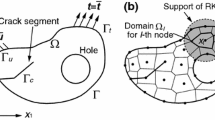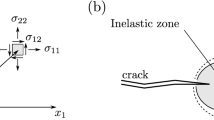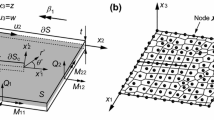Abstract
This article presents a three dimensional (3-D) formulation and implementation of a high-order domain integral method for the computation of energy release rate. The method is derived using surface and domain formulations of the J-integral and the weighted residual method. The J-integral along 3-D crack fronts is approximated by high-order Legendre polynomials. The proposed implementation is tailored for the Generalized/eXtended Finite Element Method and can handle discontinuities arbitrarily located within a finite element mesh. The domain integral calculations are based on the same integration elements used for the computation of the stiffness matrix. Discontinuities of the integrands across crack surfaces and across computational element boundaries are fully accounted for. The proposed method is able to deliver smooth approximations and to capture the boundary layer behavior of the J-integral using tetrahedral meshes. Numerical simulations of mode-I and mixed mode benchmark fracture mechanics examples verify expected convergence rates for the computed energy release rates. The results are also in good agreement with other numerical solutions available in the literature.
Similar content being viewed by others
References
Andersson B, Falk U, Babuška I, Von Petersdoff T (1995) Reliable stress and fracture mechanics analysis of complex components using a hp version of FEM. Int J Numer Methods Eng 38(13): 2135–2163
Babuška I, Caloz G, Osborn J.E. (1994) Special finite element methods for a class of second order elliptic problems with rough coefficients. SIAM J Numer Anal 31(4): 945–981
Belytschko T, Gracie R, Ventura G (2009) A review of extended/ generalized finite element methods for material modeling. Modell Simul Mater Sci Eng, 17: 24. http://dx.doi.org/10.1088/0965-0393/17/4/043001.
Cervenka J, Saouma VE (1997) Numerical evaluation of 3-D SIF for arbitrary finite element meshes. Eng Fract Mech 57(5): 541–563
Cisilino AP, Ortiz J (2005) Boundary element analysis of three-dimensional mixed-mode cracks via the interaction integral. Comput Methods Appl Mech Eng 194(9–11): 935–956
Duarte CA, Babuška I, Oden JT (2000) Generalized finite element methods for three dimensional structural mechanics problems. Comput Struct 77: 215–232
Duarte CA, Hamzeh ON, Liszka TJ, Tworzydlo WW (2001) A generalized finite element method for the simulation of three-dimensional dynamic crack propagation. Comput Methods Appl Mech Eng 190(15–17):2227–2262. doi:10.1016/S0045-7825(00)00233-4.
Duarte CAM, Oden JT (1996) Hp clouds—an hp meshless method. Numer Methods Part Differ Equ 12: 673–705
Duarte CAM, Oden JT (1996) An hp adaptive method using clouds. Comput Methods Appl Mech Eng 139: 237–262
Fries T-P, Belytschko T (2010) The generalized/extended finite element method: An overview of the method and its applications. Int J Numer Methods Eng 84: 253–304
Li FZ, Shih CF, Needleman A (1985) A comparison of methods for calculating energy release rates. Eng Fract Mech 21(2): 405–421
Li S, Mear ME, Xiao L (1998) Symmetric weak-form integral equation method for three-dimensional fracture analysis. Comput Methods Appl Mech Eng 151(3-4): 435–459
Melenk JM, Babuška I (1996) The partition of unity finite element method: Basic theory and applications. Comput Methods Appl Mech Eng 139: 289–314
Moës N, Dolbow J, Belytschko T (1999) A finite element method for crack growth without remeshing. Int J Numer Methods Eng 46: 131–150
Moës N, Gravouil A, Belytschko T (2002) Non-planar 3D crack growth by the extended finite element and level sets-Part I: mechanical model. Int J Numer Methods Eng 53: 2549–2568
Moran B, Shih CF (1987) Crack tip and associated domain integrals from momentum and energy balance. Eng Fract Mech 27(6): 615–642
Nikishkov GP, Atluri SN (1987) Calculation of fracture mechanics parameters for an arbitrary three-dimensional crack, by the ’equivalent domain integral’ method. Int J Numer Methods Eng 24(9): 1801–1821
Pereira JP, Duarte CA (2004) Computation of stress intensity factors for pressurized cracks using the generalized finite element method and superconvergent extraction techniques. In: Lyra PRM, da Silva SMBA, Magnani FS, Guimaraes L.J. do N., da Costa LM, Parente Junior E (eds) XXV Iberian Latin-American Congress on Computational Methods in Engineering, Recife, p 15. ISBN Proceedings CD: 857 409 869-8
Pereira JP, Duarte CA (2005) Extraction of stress intensity factors from generalized finite element solutions. Eng Anal Bound Elem 29: 397–413
Pereira JP, Duarte CA (2006) The contour integral method for loaded cracks. Commun Numer Methods Eng 22(5): 421–432. doi:10.1002/cnm.824
Pereira JP, Duarte CA, Guoy D, Jiao X (2009) Hp-Generalized FEM and crack surface representation for non-planar 3-D cracks. Int J Numer Methods Eng 77(5): 601–633. doi:10.1002/nme.2419
Pereira JP, Duarte CA, Jiao X, Guoy D (2009) Generalized finite element method enrichment functions for curved singularities in 3D fracture mechanics problems. Comput Mech 44(1): 73–92. doi:10.1007/s00466-008-0356-1
Rice JR (1968) A path independent integral and the approximate analysis of strain concentration by notches and cracks. J Appl Mech 35(2): 379–386
Shih CF, Moran B, Nakamura T (1986) Energy release rate along a three-dimensional crack front in a thermally stressed body. Int J Fract 30(2): 79–102
Sukumar N, Moës N, Moran B, Belytschko T (2000) Extended finite element method for three-dimensional crack modelling. Int J Numer Methods Eng 48: 1549–1570
Szabo B, Babuška I (1991) Finite element analysis. Wiley, New York
Szabo BA, Babuška I (1988) Computation of the amplitude of stress singular terms for cracks and reentrant corners. In: Cruse TA (eds) Fracture mechanics: nineteenth symposium, ASTM STP 969, Southwest Research Institute, San Antonio, pp 101–124
Szabó BA, Babuška I (1991) Finite element analysis. Wiley
Author information
Authors and Affiliations
Corresponding author
Rights and permissions
About this article
Cite this article
Ozer, H., Duarte, C.A. & Al-Qadi, I.L. Formulation and implementation of a high-order 3-D domain integral method for the extraction of energy release rates. Comput Mech 49, 459–476 (2012). https://doi.org/10.1007/s00466-011-0651-0
Received:
Accepted:
Published:
Issue Date:
DOI: https://doi.org/10.1007/s00466-011-0651-0




